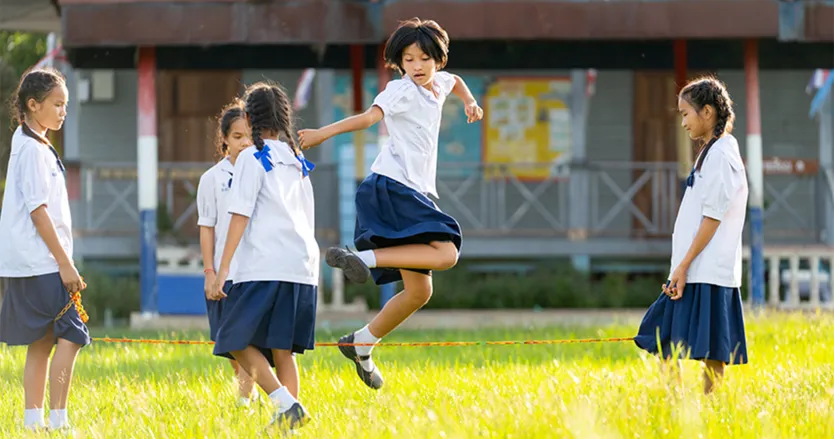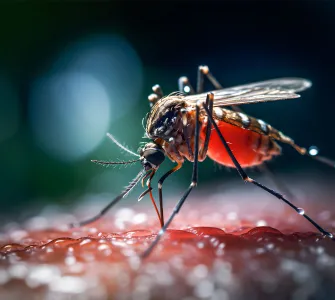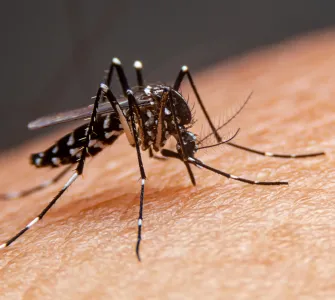Dengue can spread in schools putting children at risk


Schools are places of gathering with lots of children coming and going to and from campus every day.1,2 They can also have an abundance of breeding sites for dengue-carrying mosquitoes.1-3 This makes them a high-risk environment for the spread of dengue through the exposure of children (and staff) to the day-biting Aedes mosquitoes.1-3
A hotbed of Aedes mosquito activity
Mosquitoes can thrive in school.2-4 A study in Mexico showed that Ae. Aegypti mosquitoes were present in every one of the 24 schools tested over a 15-month period.3 Of the mosquitoes found, over 60% were present inside classrooms.3 Another study in Colombo, Sri Lanka, found over 60% of schools had live mosquito breeding sites.3
There is no shortage of places for Aedes mosquitos to breed in schools
Outside of the classroom, playgrounds, toilets, and school roofs are all suitable places for Aedes mosquitoes to lay their eggs.2 There may also be an array of water-holding containers including coolers, drums, tins, barrels, tanks, vases, and discarded containers (such as bottles or cans) available to the mosquitoes.2
In some instances, schools have had to close for extended periods of time because of the unusually high numbers of dengue cases recorded within them.5
Missing time from school because of dengue can have far-reaching effects for the child and their family.6,7
In a city (Fortaleza) of Brazil, 86% of school children (5–13 years old) studied, with confirmed with dengue (and experiencing symptoms of the disease) missed school because of their illness, for an average of 4 days.6 There was also a knock-on effect for the caregivers; for about a fifth of children with confirmed symptomatic dengue, their illness led to the primary caregiver missing work – for an average of 1.5 days.6
Everyone has a part to play in helping to keep schools safe from dengue
Children can:2
Ensure they wear long-sleeved clothes and use insect repellents
Correctly dispose of used plastic cups, glasses, and bottles
Share information with, and motivate, other children
Teachers can:2
Encourage and educate children in dengue prevention and control activities
Regularly monitor and eliminate possible school mosquito breeding sites
Ensure all water storage containers are covered and solid waste is properly disposed of
Management can:2
Coordinate with other departments e.g. health, civic and sanitation bodies
Oversee any needed repairs e.g. leakages
Schools can drive positive change within the community against dengue
“The school is one of the best places where health education and health promotion can take place.”
– World Health Organization (A dengue-free me: a campaign on the prevention and control of dengue for health promoting schools)8
Schools with their students are essential places to engage a community in dengue prevention.9,10 Studies have shown that engaging school children as “health messengers” can help bring about changes in the behavior of the wider community with respect to dengue prevention.10,11
Supporting schools the right way...
Schools with their students are in the dual position of being vulnerable to the spread of dengue but also being vital for educating communities on disease prevention.1,2,9 With this in mind, they should be both supported in preventing dengue transmission among their pupils as well as in spreading information about dengue prevention within their community.
References
Queensland Government. Available at: https://www.health.qld.gov.au/public-health/industry-environment/disease-prevention-control/mosquito-borne-dengue Accessed December 2023.
National Center for Vector Borne Diseases Control (.gov.in) Available at: https://ncvbdc.mohfw.gov.in/Doc/Guidelines/Guidelines-Prevention-Control-of-Dengue-in-School-2019.pdf Accessed December 2023.
Louis VR, et al. Pathog Glob Health. 2016;110(2):79-86.
García-Rejón JE, et al. Am J Trop Med Hyg. 2011;84(3):489-96.
Times of India. Available at: https://timesofindia.indiatimes.com/city/dehradun/residential-boys-school-closes-for-15-days-after-dengue-scare/articleshow/70999129.cms Accessed December 2023.
Coelho I, et al. Am J Trop Med Hyg. 2020;103(1):100-111. doi: 10.4269/ajtmh.19-0521.
Weerasinghe NP, et al. BMC Health Serv Res. 2022;22(1):657.
WHO. Available at: https://www.who.int/publications/i/item/urbani-school-health-kit-dengue. Accessed December 2023.
Díaz-González EE, et al. Health Educ Res. 2020 Oct 1;35(5):376-395.
Roja C, et al. Cureus. 2022;14(7):e26536.
Alok S, Nessa S, Ahil SB. School Training Strategies for Prevention and Control of Dengue. Indian J Community Med. 2020;45(1):106-107.





























